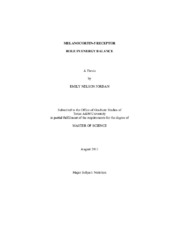| dc.description.abstract | Metabolic disorders, including obesity and fatty acid oxidation disorders (FODs), occur in approximately 34% of the American population and in 1 in every 10,000 Americans, respectively (19, 55). Melanocortin-5 receptor (MC5R) is one of five G-protein coupled receptors that are known to mediate effects of melanocortins. Emerging evidence has linked MC5R to multiple metabolic disorders. Previous studies have provided evidence that MC5R helps to regulate lipid metabolism in the skeletal muscle, liver, and white adipose tissue, and in the skin and exocrine glands of vertebrates. We, therefore, tested the hypothesis that MC5R promotes FAO in skeletal muscle. In the present study, MC5R knock-out (KO) mice and wild-type (WT) mice were placed on a low-fat or high-fat diet for 9 weeks. Methods including body weight gain and food intake determinations, behavioral testing to be assessed in future studies, insulin tolerance testing (ITT), and reverse transcription PCR (RT-PCR) were used to provide a picture of overall energy balance and metabolic activity in tissues. Results suggest that obesity induced MC5R (KO) mice, relative to WT mice, display a decrease in FAO not only in the skeletal muscle, but in the liver as well. We also show that to compensate for the loss of FAO in skeletal muscle, MC5R KO mice experience an increase in FAO in brown adipose tissue (BAT) and an increase in adipogenesis in the liver. Not only does lipid metabolism activity shift to liver, data suggests that the glycolytic activity in skeletal muscle decreases and is again reallocated to the liver. Furthermore, we demonstrate that insulin sensitivity is maintained in MC5R KO mice on high-fat diet, in contrast to the decrease in sensitivity in WT mice on high-fat diet. These data collectively suggest that MC5R is extensively involved in overall lipid and glucose metabolism and not only shifts lipolysis and lipogenesis in the body, but may be involved in the dissociation of obesity and insulin resistance. | en |


